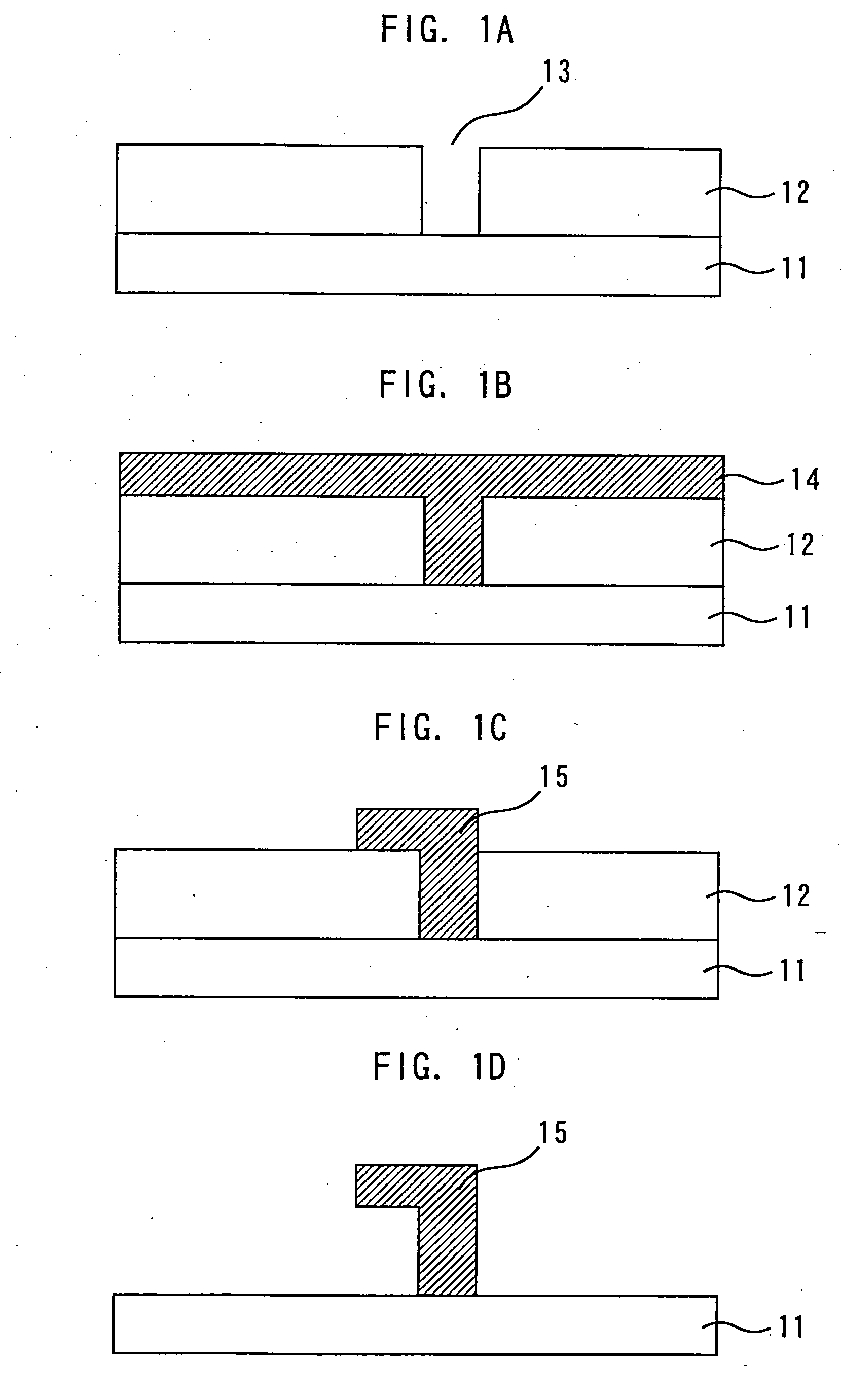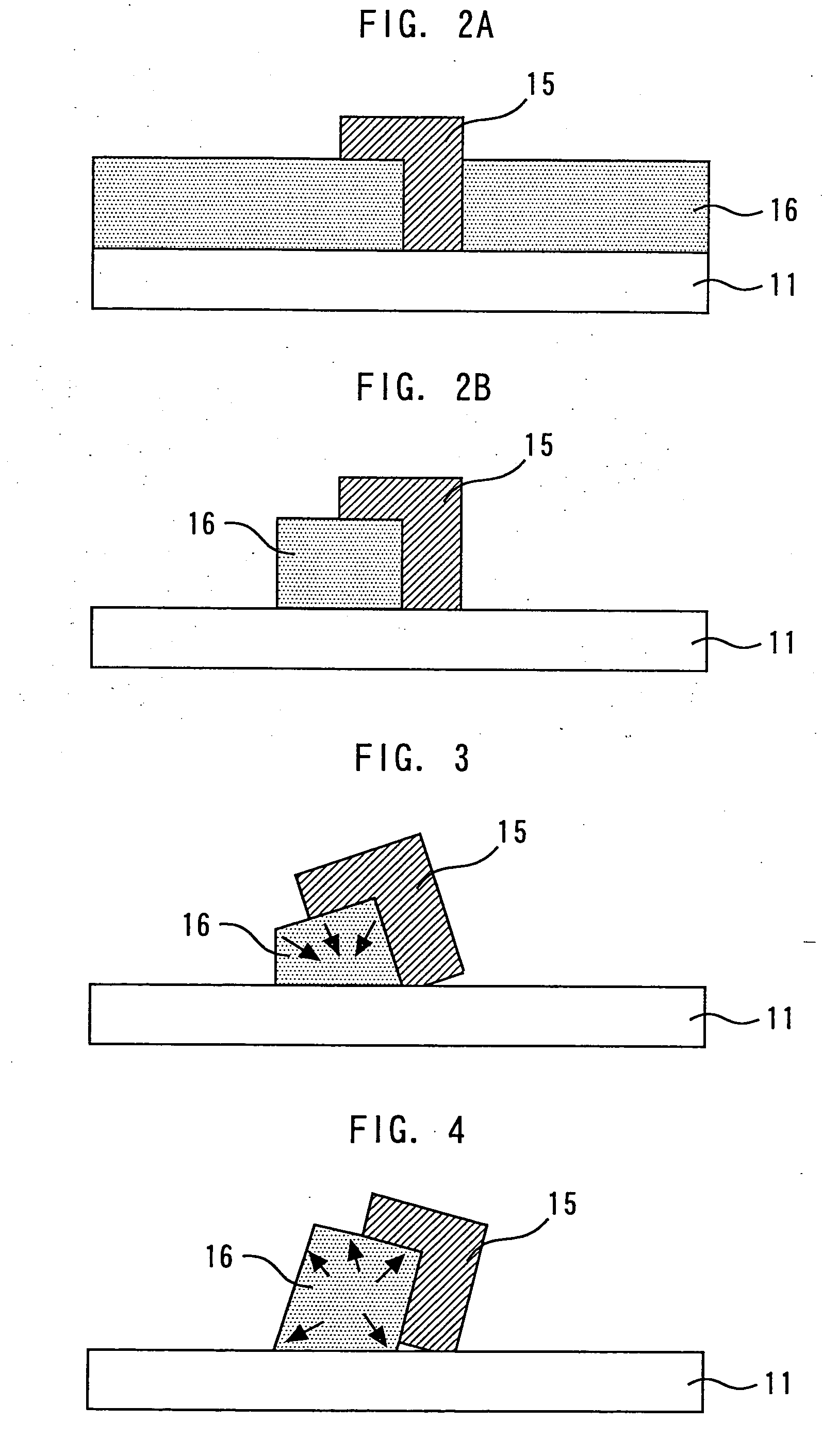Method of manufacturing semiconductor device
a manufacturing method and semiconductor technology, applied in the direction of semiconductor devices, basic electric elements, electrical appliances, etc., can solve the problems of difficult to obtain a high frequency over 100 ghz, limit to and difficult to manufacture a gate electrode having a gate length of about 0.1 m long, etc., to achieve the effect of simple method and shorten the gate length
- Summary
- Abstract
- Description
- Claims
- Application Information
AI Technical Summary
Benefits of technology
Problems solved by technology
Method used
Image
Examples
first embodiment
[0023] Descriptions will be hereinafter given of a method of manufacturing a semiconductor device according to a first embodiment of the invention with reference to FIGS. 1A-1D, 2A, 2B, 3 and 4.
[0024] First, as shown in FIG. 1A, an insulating film 12 made of SiN or the like is formed on a semiconductor substrate 11 made of GaAs or the like. Then, an opening 13 is formed in the insulating film 12 by EB or photolithography.
[0025] Next, as shown in FIG. 1B, a metal film 14 made of Al or the like is formed on a whole area to infill the opening 13. Then, as shown inFIG. 1C, the metal film 14 is provided with patterning by photo lithography to form a gate electrode 15 having a Γ-shape cross section. After that, as shown in FIG. 1D, the insulating film 12 is removed. By the foregoing steps, the gate electrode is formed on the semiconductor substrate.
[0026] Next, as shown in FIG. 2A, a resist 16 is formed on a whole area of the semiconductor substrate 11. Then, as shown in FIG. 2B, by ex...
second embodiment
[0030] In the first embodiment, the cross section shape of the gate electrode is Γ. Meanwhile, in a second embodiment, a gate electrode 17 having a T-shape cross section as shown in FIG. 5 is used, or a gate electrode 18 having a Y-shape cross section as shown in FIG. 6 is used. In the case that a cross section of the gate electrode is T shape or Y shape as above, the resist gets in below the gate electrode, and shrinkage or expansion force is easily applied similarly to in the case of Γ shape in the first embodiment. Therefore, in the second embodiment, effects similar to in the first embodiment can be obtained.
third embodiment
[0031] In the third embodiment, a drain electrode 19 and a source electrode 20 are provided on the semiconductor substrate 11, and the gate electrode 15 is tilted to the source side. Thereby, without shifting an exposure position of the gate electrode 15 to the source side, a distance between the drain electrode 19 and the gate electrode 15 can be lengthened. Therefore, it is possible to reduce a capacity Cgd between the gate and the drain, and increase a withstand pressure Vgdo between the gate and the drain. Thereby, not only a high-frequency semiconductor device can be realized, but also a high-gain and high-withstanding pressure semiconductor device can be realized.
PUM
| Property | Measurement | Unit |
|---|---|---|
| gate length | aaaaa | aaaaa |
| frequency | aaaaa | aaaaa |
| volume | aaaaa | aaaaa |
Abstract
Description
Claims
Application Information
 Login to View More
Login to View More - R&D
- Intellectual Property
- Life Sciences
- Materials
- Tech Scout
- Unparalleled Data Quality
- Higher Quality Content
- 60% Fewer Hallucinations
Browse by: Latest US Patents, China's latest patents, Technical Efficacy Thesaurus, Application Domain, Technology Topic, Popular Technical Reports.
© 2025 PatSnap. All rights reserved.Legal|Privacy policy|Modern Slavery Act Transparency Statement|Sitemap|About US| Contact US: help@patsnap.com



